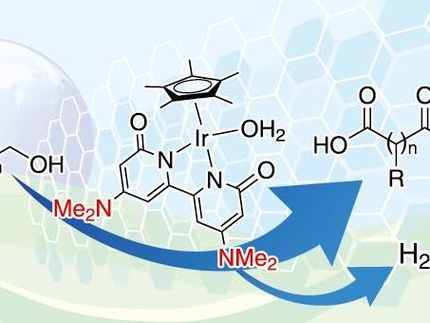Novel anion-conducting membranes for electrolysis
Cost-effective and environmentally friendly
Advertisement
How to produce hydrogen cost-effectively and sustainably is one of the central questions of the energy transition. Highly conductive membranes for electrolyzers are a key component of hydrogen technology. A research team at Fraunhofer Institute for Applied Polymer Research IAP, together with Zentrum für Brennstoffzellen Technik ZBT GmbH, has now developed innovative anion exchange membranes (AEM) that allow to reduce the costs of electrolyzers and to tap the potential of hydrogen as a climate-neutral energy source in an environmentally friendly way.
Researchers at Fraunhofer IAP succeeded in synthesizing a new class of promising anion exchange polymers and manufacturing membranes from them. They are the basis for the development of low-cost, efficient electrolyzers - so-called anion exchange membrane water electrolyzers (AEM-WE). "Our membranes make it possible to manufacture AEM-WEs that in principle do not require precious metals and do not contain per- and polyfluoroalkyl substances (PFAS). We are thus paving the way for innovative system architectures that are both inexpensive and environmentally friendly," says Dr. Taybet Bilkay-Troni, head of the Polymers and Electronics department at Fraunhofer IAP, explaining the advantages of the novel polymer technology. The development of the new anion exchange polymers and the resulting membranes is an important step for the hydrogen industry in Germany. "Manufacturers of electrolyzers as well as their suppliers will benefit from the knowledge we have gained," Bilkay-Troni emphasizes.
Cost-effective and environmentally friendly
Currently available membranes are based on the principle of proton conduction used in proton exchange membrane water electrolysis (PEM-WE). This requires catalysts made of expensive precious metals, such as iridium. Those membranes also contain a high proportion of PFASs, which degrade poorly in the environment and are suspected to possibly cause cancer. The newly developed anion exchange membranes, on the other hand, enable electrolysis operation with low-cost transition metals. They are free of PFAS and therefore applicable in line with the planned restriction process for PFAS within the EU chemicals regulation REACH beyond 2025.
Until now, the development of AEMs has lacked highly conductive materials that are chemically stable and can withstand the conditions in alkaline electrolyzers and fuel cells. "We are now closing this gap with our newly developed polymers," explains Bilkay-Troni. The novel PFAS-free polyphenylquinoxalines (PPQs) exhibit very good alkali stability. Based on the PPQs, the team at Fraunhofer IAP created hydroxide ion-conductive membranes suitable for applications in electrolyzers. The performance was evaluated by in-situ tests conducted by Zentrum für Brennstoffzellen Technik ZBT GmbH. In electrolysis operation, the new membranes achieve a current density of 0.5 amperes per square centimeter at a voltage of two volts. The specific conductivity for hydroxide ions of the newly developed membranes is about eight millisiemens per centimeter at 60 degrees Celsius and 95 percent relative humidity. "The membranes are being further developed to increase their anion conductivity. The goal is to reach 40 millisiemens per centimeter under the same conditions to be competitive with pre-commercial AEM materials. With the novel polymers, we are well on our way to significantly improving the conductivity, stability, and thus the performance of electrolyzers. In addition, these AEM materials could also be used in fuel cells in the future," summarize Dr. Ivan Radev and Miriam Hesse, project managers at Zentrum für Brennstoffzellen Technik ZBT GmbH.




































































